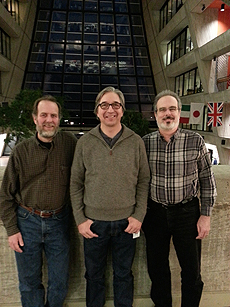DZero invites Fermilab family and the public to tour detector
 |
| These Fermilab physicists organize DZero tours led by physicists involved in the DZero experiment. From left: Bill Lee, Stefan Gruenendahl and George Ginther. Rich Blaustein, OC |
This fall, the DZero site welcomed its 2,500th visitor since arranged tours began in February 2012. Fermilab physicist and DZero co-spokesperson Dmitri Denisov hopes this milestone will spur on more of the Fermilab community and the public to tour the DZero detector site, where its namesake, the DZero detector, operated from 1992 to 2011 and enabled landmark Tevatron results, including the discovery of the top quark. Scientists continue to analyze the data collected by the DZero detector as well as from the Tevatron's other general-purpose detector, CDF.
"It is a great opportunity for Fermilab employees and for the public to see the wonder of the engineering and the technology that goes into a complex particle accelerator detector," Denisov said. "When people tour here, they feel that it is like a rocket launch. It really makes you say, 'Wow! People can really do such complex, amazing, wonderful things.'"
Fermilab physicist Stefan Gruenendahl organizes the tours with help from his DZero run coordination team colleagues George Ginther and Bill Lee. The tours are led by a team of DZero physicists.
"We think that gives people a more intimate experience, because the people who give the tour really did work on it," Ginther said.
Local high school and college classes, Saturday Morning Physics groups, and Fermilab personnel and their family members have made up the typical tour groups so far.
Tours include stops at the DZero assembly hall, the control room (where the screens replay images captured during DZero detector operation) and the Tevatron tunnel. They culminate in the detector and its collision hall. In the assembly hall area there is a special explanatory display, recently enhanced by 10th grade science teacher Lia Koonce of Chicago's Institute of Health and Sciences Career Academy.
Denisov, Ginther and Gruenendahl all emphasize that visiting the DZero sites gives a good sense of currently operating collider detectors.
"They all have the same scheme: vacuum pipe, tracking detectors, magnet, calorimeter and muon identification," Ginther said. "'The detector you see at DZero operated on the same principles as those that are running at the Large Hadron Collider in CERN and other detectors around the world. There are different choices in technology, but the concepts are exactly the same."
Gruenendahl added that you can get up-close views at DZero.
"They have tours at CMS and ATLAS at CERN, but you can not go into the accelerator and into the collider detector there as you can here," he said.
Those interested in the free tour can visit Education Office Web page on DZero tours.
—Rich Blaustein
|